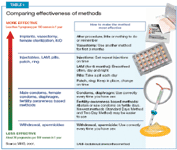Helping teens choose the right contraceptive
Finding the best contraceptive for each patient requires that you consider not only medical contraindications but also psychosocial variables that affect the adolescent's ability to use contraception effectively.

Key Points
Half of all pregnancies among US women are unintended; the percentage is even higher for adolescents.1 In 2001, more than 80% of the approximately 840,000 pregnancies among women younger than 20 years were unintended, and 40% ended in abortion.1
Despite a recent sharp decline in pregnancy rates among teenagers-27% between 1990 and 2000, to an historic low of 84 pregnancies per 1,000 women aged 15 to 19 years2 -absolute numbers of unintended pregnancies and abortions among adolescents remain high, and US rates compare unfavorably with those of other industrialized countries. The decrease in teenage pregnancies has been attributed to changes in both sexual behavior and contraceptive use, although improved contraceptive use has been the primary determinant of declining rates.3
The 2002 National Survey of Family Growth (NSFG) reported that 46% of adolescents had ever had sex-down from 51% in 1988.4 Adolescents are also postponing sex until older ages. In 2002, 13% of teens reported having sex before age 15, compared with 19% in 1995.4
In 2002, 83% of adolescents reported using some form of contraception at last intercourse, compared to 71% in 1995.5 Teenagers choose a variety of reversible contraceptive options, including both hormonal and barrier methods. Male condoms remain the most common method used by young women between 15 and 19 years of age, followed by oral contraceptives (OCs).4 Use of the injectable contraception depot medroxyprogesterone acetate (DMPA) is increasing, from 10% of sexually active adolescents in the 1995 NSFG to 21% in 2002.4 Growing numbers of adolescents are also choosing the transdermal patch.
A complex choice
Choosing a method of contraception is an important decision that requires weighing many variables, including effectiveness, safety, and personal and psycho-social considerations. Rarely, medical con-traindications can cause serious health consequences. A method may be ineffective or unsuitable for a particular adolescent, leading to unintended pregnancy. A method that does not suit the user's lifestyle can lead to contraceptive failure resulting from incorrect or inconsistent use or discontinuation.
Clinicians who provide reproductive health services to adolescents need to consider not only relevant medical contraindications but also key personal and psychosocial variables that will ultimately influence whether the teenager can use a contraceptive effectively and long-term. They include:
How well do contraceptives work?

